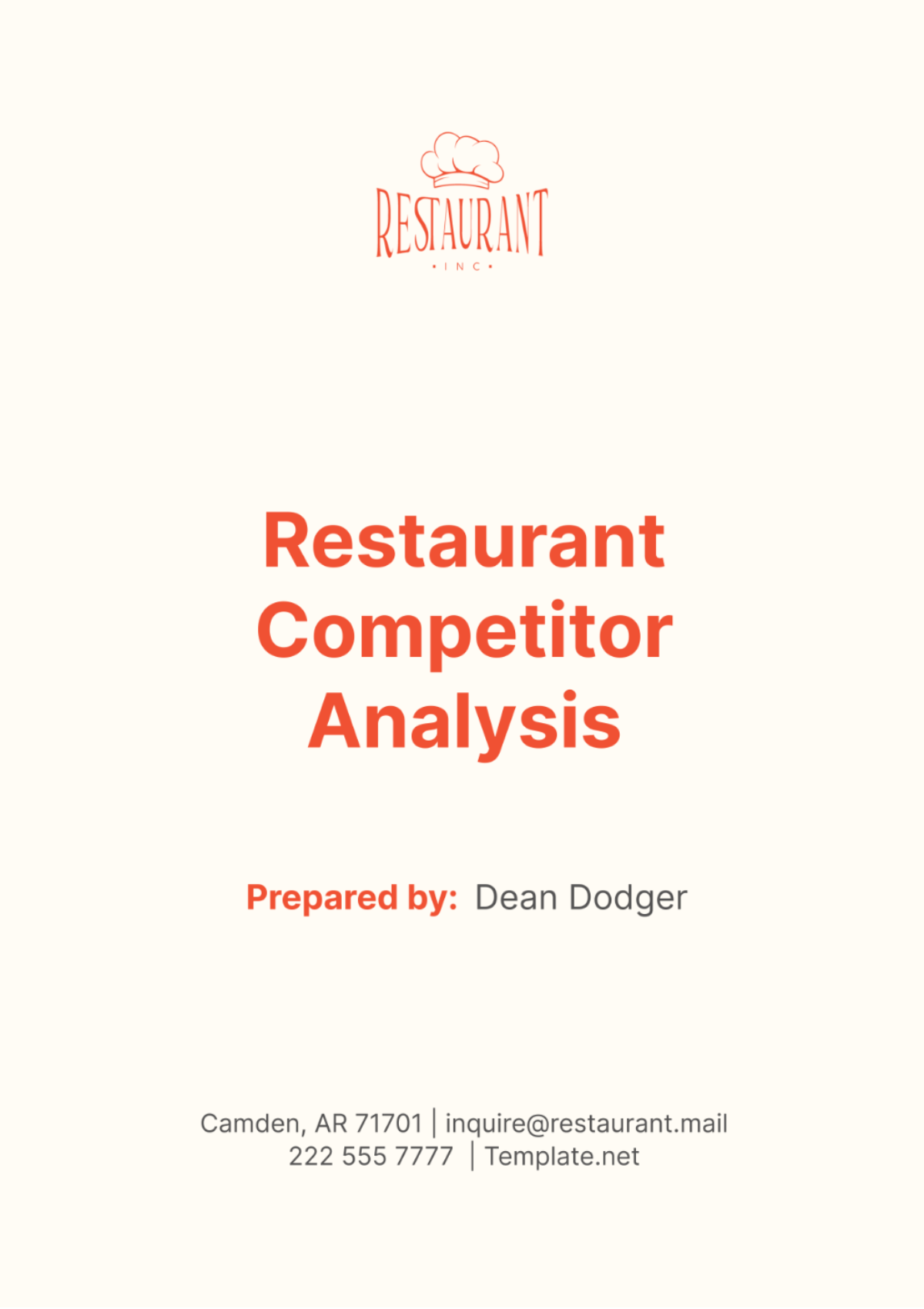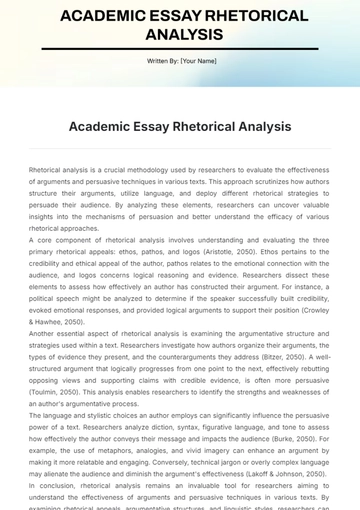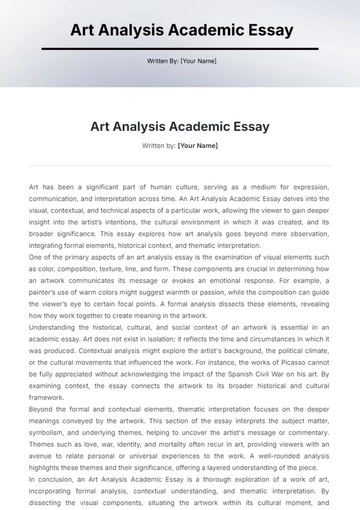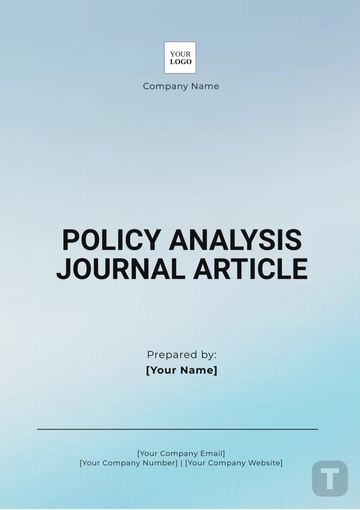Free Restaurant Competitor Analysis

I. Introduction
The primary objective of the Restaurant Competitor Analysis is to furnish comprehensive insights into the competitive dynamics of the restaurant industry within the Downtown Metropolis area. This analysis will delve into identifying and evaluating the strengths and weaknesses of competing dining establishments, as well as pinpointing the opportunities available and threats that could be faced by these competitors. By thoroughly understanding these elements, the analysis will be instrumental in formulating effective strategies that will significantly improve and augment the competitive edge of our restaurant in the marketplace.
II. Identification of Competitors
A. Direct Competitors
Restaurant Name | Cuisine | Average Price ($) | Key Strengths |
|---|---|---|---|
[Competitor A] | Italian | 20-30 | Authentic Italian cuisine, cozy ambiance |
[Competitor B] | Indian | 15-25 | Flavorful Indian dishes, affordable prices |
[Competitor C] | American | 25-35 | Premium steaks, elegant dining experience |
B. Indirect Competitors
Restaurant Name | Cuisine | Average Price ($) | Key Strengths |
|---|---|---|---|
[Competitor D] | Vegetarian | 15-20 | Fresh and healthy options, vegan-friendly |
[Competitor E] | European | 20-25 | Artisanal coffee, pastries, casual dining |
III. Product and Service Offerings
A. Menu Analysis
[Competitor A] offers a diverse menu featuring classic Italian dishes such as pasta, pizza, and risotto, with an average price range of $20-$30. [Competitor B] specializes in Indian cuisine, offering a variety of curries, tandoori dishes, and naan bread at an average price of $15-$25. [Competitor C] focuses on American cuisine, with a menu highlighting premium steaks, seafood, and gourmet burgers priced between $25-$35.
B. Pricing Strategy
All competitors offer competitive pricing relative to the quality and type of cuisine they serve. While [Competitor C] targets a higher-end market with premium pricing, [Competitor B] and [Competitor A] appeal to a broader customer base with affordable yet quality offerings.
C. Food Quality and Presentation
Customer reviews indicate high satisfaction with the food quality and presentation across all competitors. [Competitor A] and [Competitor C] receive praise for their premium ingredients and elegant plating, while [Competitor B] excels in delivering authentic flavors and spice levels.
D. Service Standards
[Competitor B] and [Competitor C] are commended for their attentive and friendly service staff, ensuring a positive dining experience for customers. [Competitor A] also receives positive feedback for its knowledgeable servers and efficient service.
E. Dining Experience
[Competitor C] distinguishes itself with its upscale ambiance and fine dining experience, attracting customers seeking a special occasion dining experience. [Competitor A] and [Competitor B] offer a more casual yet inviting atmosphere suitable for family dinners or casual outings.
IV. Market Positioning and Branding
A. Brand Identity
[Competitor A] is positioned as an authentic Italian dining destination, emphasizing traditional recipes and a warm, family-friendly ambiance. [Competitor B] positions itself as a taste of India in Downtown Metropolis, showcasing vibrant flavors and spices in a contemporary setting. [Competitor C] is positioned as a premium steakhouse, offering top-quality meats and a sophisticated dining experience.
B. Target Audience
The target audience for [Competitor A] comprises families, couples, and individuals seeking a taste of Italy in a cozy setting. [Competitor B] targets spice enthusiasts, curry lovers, and those interested in exploring Indian cuisine. [Competitor C] caters to affluent diners, business professionals, and special occasion celebrants.
C. Unique Selling Proposition (USP)
[Competitor A]'s USP lies in its authentic Italian recipes passed down through generations and its commitment to using fresh, locally sourced ingredients. [Competitor B]'s USP is its dedication to delivering the true flavors of India through carefully crafted recipes and traditional cooking methods. [Competitor C] distinguishes itself with its premium cuts of meat, extensive wine selection, and elegant ambiance.
D. Brand Perception Among Customers
Customer surveys indicate a positive perception of all competitors, with high ratings for food quality, service, and overall dining experience. [Competitor A] and [Competitor B] are often praised for their value for money, while [Competitor C] is regarded as a top choice for special occasions and celebrations.
V. Location and Accessibility
A. Geographic Distribution of Competitors
All competitors are strategically located in key areas of [Address], ensuring accessibility and visibility to a wide customer base.
B. Proximity to Key Amenities
[Competitor A] and [Competitor B] are situated near popular tourist attractions and shopping districts, attracting both locals and visitors. [Competitor C] benefits from its proximity to luxury hotels and business centers, catering to business travelers and affluent diners.
C. Parking Availability
[Competitor C] offers valet parking services for customer convenience, while [Competitor A] and [Competitor B] rely on nearby parking garages and street parking, which may be limited during peak hours.
D. Public Transportation Access
All competitors are easily accessible via public transportation, with nearby bus stops and subway stations providing convenient access for commuters and tourists alike.
VI. Online Presence and Reputation
A. Website Analysis
[Competitor A]'s website features an intuitive layout, showcasing its menu, reservation options, and customer testimonials. [Competitor B]'s website highlights its menu offerings, catering services, and online ordering platform. [Competitor C]'s website emphasizes its upscale ambiance, private dining options, and wine selection.
B. Social Media Presence
All competitors maintain active profiles on popular social media platforms such as Facebook, Instagram, and Twitter, regularly posting updates on menu specials, events, and promotions to engage with customers.
C. Online Reviews and Ratings
Customer reviews on platforms like Yelp and Google Maps indicate positive sentiment towards all competitors, with high ratings for food quality, service, and atmosphere.
D. Customer Engagement
[Competitor A] and [Competitor B] actively engage with customers through social media contests, polls, and interactive posts, fostering a sense of community and loyalty. [Competitor C] offers exclusive promotions and discounts to its email subscribers, encouraging repeat visits and customer retention.
VII. Sales and Marketing Strategies
A. Advertising Channels and Tactics
All competitors utilize a mix of traditional and digital advertising channels, including print ads, radio spots, social media ads, and influencer partnerships, to reach their target audience and drive foot traffic.
B. Promotional Campaigns
Seasonal promotions, holiday specials, and loyalty rewards programs are implemented by all competitors to attract customers and incentivize repeat visits.
C. Loyalty Programs
[Competitor A] offers a loyalty program where customers earn points for every purchase, redeemable for discounts or free meals. [Competitor B] provides a referral program where customers receive discounts for referring friends and family. [Competitor C] offers a VIP membership program with exclusive perks such as priority reservations and special event invitations.
D. Partnerships and Collaborations
All competitors collaborate with local businesses, event organizers, and charities to host community events, fundraisers, and food festivals, increasing brand visibility and goodwill.
VIII. Financial Performance
A. Revenue Trends
Although specific financial data is not publicly available, anecdotal evidence suggests that all competitors have maintained steady revenue growth over the past few years, driven by a combination of increased foot traffic and effective marketing strategies.
B. Profitability Analysis
While profitability margins may vary based on factors such as overhead costs and menu pricing, all competitors demonstrate healthy profitability levels, indicating efficient cost management and strong customer demand.
C. Growth Trajectory
[Competitor A] and [Competitor B] have expanded their operations with new locations in neighboring cities, capitalizing on their brand reputation and customer loyalty. [Competitor C] has focused on enhancing its existing location with renovations and menu updates to maintain its premium positioning.
D. Market Share
Although exact market share data is unavailable, all competitors are well-established within the Downtown Metropolis restaurant scene, each commanding a significant share of the market based on their unique offerings and customer appeal.
IX. SWOT Analysis
A. Strengths
Strong brand reputation and customer loyalty
High-quality food offerings and attentive service
Strategic locations with convenient access
B. Weaknesses
Reliance on seasonal tourism for foot traffic
Limited parking availability during peak hours
Vulnerability to economic downturns and external factors
C. Opportunities
Expansion into catering services and private events
Introduction of new menu items or culinary experiences
Collaboration with local suppliers for sustainable sourcing
D. Threats
Competition from emerging restaurants and food delivery services
Changing consumer preferences and dietary trends
Regulatory changes impacting operations and costs
X. Conclusion
In conclusion, the Restaurant Competitor Analysis reveals a dynamic and competitive landscape within the Downtown Metropolis restaurant market. By leveraging strengths, addressing weaknesses, and capitalizing on opportunities, our restaurant can enhance its position and continue to thrive in the ever-evolving industry.
- 100% Customizable, free editor
- Access 1 Million+ Templates, photo’s & graphics
- Download or share as a template
- Click and replace photos, graphics, text, backgrounds
- Resize, crop, AI write & more
- Access advanced editor
Manage your restaurant's competitive edge with ease using the Restaurant Competitor Analysis Template from Template.net. This editable and customizable tool offers a comprehensive framework to analyze rivals' strengths and weaknesses, crafted for efficiency with an intuitive AI Editor Tool. Elevate your strategic planning and stay ahead in the culinary landscape with this essential resource.





























